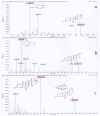Validation of a rapid and sensitive LC-MS/MS method for determination of exemestane and its metabolites, 17β-hydroxyexemestane and 17β-hydroxyexemestane-17-O-β-D-glucuronide: application to human pharmacokinetics study
- PMID: 25793887
- PMCID: PMC4368747
- DOI: 10.1371/journal.pone.0118553
Validation of a rapid and sensitive LC-MS/MS method for determination of exemestane and its metabolites, 17β-hydroxyexemestane and 17β-hydroxyexemestane-17-O-β-D-glucuronide: application to human pharmacokinetics study
Abstract
A novel, rapid and sensitive liquid chromatography-tandem mass spectrometric (LC-MS/MS) method was developed and validated for the evaluation of exemestane pharmacokinetics and its metabolites, 17β-dihydroexemestane (active metabolite) and 17β-dihydroexemestane-17-O-β-D-glucuronide (inactive metabolite) in human plasma. Their respective D3 isotopes were used as internal standards. Chromatographic separation of analytes was achieved using Thermo Fisher BDS Hypersil C18 analytic HPLC column (100 × 2.1 mm, 5 μm). The mobile phase was delivered at a rate of 0.5 mL/min by gradient elution with 0.1% aqueous formic acid and acetonitrile. The column effluents were detected by API 4000 triple quadrupole mass spectrometer using electrospray ionisation (ESI) and monitored by multiple reaction monitoring (MRM) in positive mode. Mass transitions 297 > 121 m/z, 300 > 121 m/z, 299 > 135 m/z, 302 > 135 m/z, 475 > 281 m/z, and 478 > 284 m/z were monitored for exemestane, exemestane-d3, 17β-dihydroexemestane, 17β-dihydroexemestane-d3, 17β-dihydroexemestane-17-O-β-D-glucuronide, and 17β-dihydroexemestane-17-O-β-D-glucuronide-d3 respectively. The assay demonstrated linear ranges of 0.4-40.0 ng/mL, for exemestane; and 0.2-15.0 ng/mL, for 17β-dihydroexemestane and 17β-dihydroexemestane-17-O-β-D-glucuronide, with coefficient of determination (r2) of > 0.998. The precision (coefficient of variation) were ≤10.7%, 7.7% and 9.5% and the accuracies ranged from 88.8 to 103.1% for exemestane, 98.5 to 106.1% for 17β-dihydroexemestane and 92.0 to 103.2% for 17β-dihydroexemestane-17-O-β-D-glucuronide. The method was successfully applied to a pharmacokinetics/dynamics study in breast cancer patients receiving exemestane 25 mg daily orally. For a representative patient, 20.7% of exemestane in plasma was converted into 17β-dihydroexemestane and 29.0% of 17β-dihydroexemestane was inactivated as 17β-dihydroexemestane-17-O-β-D-glucuronide 24 hours after ingestion of exemestane, suggesting that altered 17-dihydroexemestane glucuronidation may play an important role in determining effect of exemestane against breast cancer cells.
Conflict of interest statement
Figures




Similar articles
-
A liquid chromatography-tandem mass spectrometry method for the simultaneous determination of exemestane and its metabolite 17-dihydroexemestane in human plasma.J Mass Spectrom. 2009 Jun;44(6):920-8. doi: 10.1002/jms.1566. J Mass Spectrom. 2009. PMID: 19214962
-
Determination of tapentadol and tapentadol-O-glucuronide in human serum samples by UPLC-MS/MS.J Chromatogr B Analyt Technol Biomed Life Sci. 2015 Feb 15;981-982:40-7. doi: 10.1016/j.jchromb.2014.12.013. Epub 2015 Jan 8. J Chromatogr B Analyt Technol Biomed Life Sci. 2015. PMID: 25600054
-
Simultaneous analysis of glucocorticosteroid fluticasone propionate and its metabolite fluticasone propionate 17β-carboxylic acid in human plasma by UPLC-MS/MS at sub pg/mL level.J Pharm Biomed Anal. 2017 Feb 20;135:1-7. doi: 10.1016/j.jpba.2016.12.008. Epub 2016 Dec 8. J Pharm Biomed Anal. 2017. PMID: 27987390
-
Androgen glucuronides analysis by liquid chromatography tandem-mass spectrometry: could it raise new perspectives in the diagnostic field of hormone-dependent malignancies?J Chromatogr B Analyt Technol Biomed Life Sci. 2013 Dec 1;940:24-34. doi: 10.1016/j.jchromb.2013.09.022. Epub 2013 Sep 27. J Chromatogr B Analyt Technol Biomed Life Sci. 2013. PMID: 24140653 Review.
-
Bioanalytical challenges and strategies for accurately measuring acyl glucuronide metabolites in biological fluids.Biomed Chromatogr. 2020 Jan;34(1):e4640. doi: 10.1002/bmc.4640. Epub 2019 Aug 20. Biomed Chromatogr. 2020. PMID: 31256423 Review.
Cited by
-
Therapeutic Drug Monitoring of Oral Anti-Hormonal Drugs in Oncology.Clin Pharmacokinet. 2019 Mar;58(3):299-308. doi: 10.1007/s40262-018-0683-0. Clin Pharmacokinet. 2019. PMID: 29862467 Review.
-
Variation in the UGT2B17 genotype, exemestane metabolism and menopause-related toxicities in the CCTG MAP.3 trial.Breast Cancer Res Treat. 2020 Oct;183(3):705-716. doi: 10.1007/s10549-020-05812-1. Epub 2020 Aug 1. Breast Cancer Res Treat. 2020. PMID: 32715442 Free PMC article.
-
Development and Validation of a Robust RP-HPLC Method for the Simultaneous Analysis of Exemestane and Thymoquinone and Its Application to Lipid-Based Nanoformulations.ACS Omega. 2024 Jul 3;9(28):30120-30130. doi: 10.1021/acsomega.3c08078. eCollection 2024 Jul 16. ACS Omega. 2024. PMID: 39035924 Free PMC article.
-
Simultaneous Quantification of Aromatase Inhibitors and Estrogens in Postmenopausal Breast Cancer Patients.J Clin Endocrinol Metab. 2022 Apr 19;107(5):1368-1374. doi: 10.1210/clinem/dgab923. J Clin Endocrinol Metab. 2022. PMID: 34958096 Free PMC article.
-
A Review on Liquid Chromatography-Tandem Mass Spectrometry Methods for Rapid Quantification of Oncology Drugs.Pharmaceutics. 2018 Nov 8;10(4):221. doi: 10.3390/pharmaceutics10040221. Pharmaceutics. 2018. PMID: 30413076 Free PMC article. Review.
References
-
- Kim SH, Park IH, Lee H, Lee KS, Nam BH, Ro J. Efficacy of exemestane after nonsteroidal aromatase inhibitor use in metastatic breast cancer patients. Asian Pac J Cancer Prev., 2012; 13(3): 979–983. - PubMed
Publication types
MeSH terms
Substances
LinkOut - more resources
Full Text Sources
Other Literature Sources

